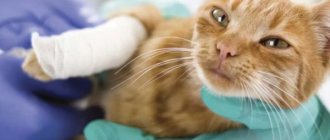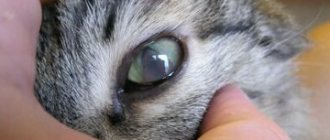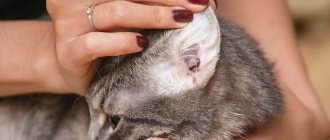Home » Cats » Cat health » Why does a cat limp on its front leg?
Cats are distinguished by their activity, which sometimes causes them to suffer. Their excessive mobility can cause injuries of various origins. If you notice that your cat is limping on its front leg, then you need to contact a veterinarian and undergo an examination.
Why does a cat limp on its front leg?
Cat lameness can be caused by many things and can cause the animal significant discomfort and pain. The disease can be permanent or occur periodically, for example, only in the morning or evening. Causes of lameness in cats associated with injury are as follows:
- dislocation of the paw during games;
- splinter in the fingertips;
- sprain;
- fracture;
- claw damage.
An animal may also limp due to a specific disease:
- osteochondrosis. Occurs mainly in old cats. In this case, pinching of the spinal cord roots occurs. Affecting the cervical region, pinching leads to lameness of one front paw or both. The older the pet, the more severe osteochondrosis will manifest itself;
- elbow dysplasia. Mainly affects purebred cats. The disease manifests itself in youth and only intensifies over the years. In this case, the lameness affects either one of the front legs or both at once;
- arthritis or arthrosis. Occurs in older cats and leads to inflammation of the joints. With this disease, the cat limps on its front or hind legs. The animal begins to limp gradually. Osteoarthritis can affect older animals and overweight cats;
- osteomyelitis. Characterized by partial destruction of bone tissue. The disease can affect any of the four limbs. It mainly affects cats under two years of age. Osteomyelitis is typical for Persians and related breeds;
- infections, such as calcivirus. In addition to limping, the animal may experience nasal discharge, oral ulcers, and fever.
Your pet may not be able to step on his front paw due to damaged nails. This happens as a result of a fall from a great height or an impact. The claw can break if someone steps on the paw. This causes the animal great discomfort and pain.
There is another reason for lameness related to the disposition of the animal. For example, if you accidentally stepped on its paw and crushed it under a door, the animal will begin to limp demonstratively, expressing its resentment. The main thing is not to pay attention to this, and after a couple of hours your pet will get tired of playing and stop pretending.
If you notice that the cat is really suffering, immediately take him to the veterinarian to eliminate the possibility of complications.
The animal does not stand on a sore paw
Elbow dysplasia
This disease is not considered the most typical for cats, but... Yes, in the case of outbred “Murks” everything is exactly like that. They practically do not suffer from this pathology; cases are extremely rare. It’s just that in recent years things have been much sadder with purebred cats. The problem is selection. More precisely, in poorly carried out selection: many animals end up in breeding that should not have been allowed there, as a result of which the breed acquires many “bad” genes. The characteristics of the pathology are as follows:
- As is easy to understand, the forelimbs are affected (as a rule, the pathology is well manifested only on one paw).
- The disease is hereditary. If you do not know the breeder, and there are no people among your acquaintances who bought kittens from him, it is better not to take risks. Animals must be purchased only from trusted persons who will not allow sick pets into breeding.
- Elbow dysplasia is diagnosed at the age of two or three years, or even earlier.
- The severity of symptoms varies greatly from cat to cat. Your pet may be lucky, and then he will only be bothered by intermittent claudication, or he may be unlucky, and then without surgery he will not be able to fully move.
Therapy (full) is exclusively surgical. Anti-inflammatory drugs, painkillers, etc. are prescribed only in mild cases when the body’s compensatory reserves have not yet been exhausted. When the cat is already noticeably falling on the sore paw, drug treatment will not give much effect.
Symptoms of lameness
An animal can limp with varying degrees of severity. Some slightly twist their paw when walking, others cannot step on it at all. Observe your pet, conduct a visual examination and run to the doctor if you notice at least one of the following signs:
- the cat cannot walk at all or moves with difficulty;
- after touching the paw, the cat pulls it away and begins to whine;
- refuses to go outside, especially if you have to go up or down stairs;
- the animal does not stand on its paw;
- with a fungal infection, a trace of dermatophytes is visible on the paws.
In addition to physical signs, your cat may lose appetite, become tired, lethargic, or irritable. If you forcefully examine a painful limb, the cat may hiss and even claw you.
If you notice lameness in your cat, delay visiting the veterinary clinic.
Osteochondrosis
Yes, this disease is not limited to humans. Old cats can also suffer from it to a no lesser extent, as they begin to limp severely and lose their former mobility. By the way, how can osteochondrosis, a disease of the spine, cause lameness?
In fact, there is nothing strange about this. The fact is that with this disease the spinal roots can be pinched and pinched. The innervation of the limbs is disrupted, which is why lameness occurs. Pathology manifests itself as follows:
- Any limb can be affected; with severe pinching, even the size of the front paws (or hind paws, depending on your luck) is observed.
- It is believed that the disease develops due to a disruption in the process of normal formation of cartilage tissue in the animal’s body. Because of this, the layers of cartilage between the vertebrae (not the discs) are simply erased, the vertebral processes begin to rub “dry,” and the animal experiences severe pain.
- It is assumed that osteochondrosis in cats is a hereditary disease. Again, be more attentive to the pedigree of your intended pet before purchasing a kitten.
In the initial stages, when the manifestations of the disease are still minor, anti-inflammatory corticosteroids can be used. If progressive lameness and other signs of pinched nerves are visible to the naked eye, surgical intervention is necessary. The operation is expensive and quite risky, but, alas, it will not be possible to do without it. What other causes of lameness in cats exist?
Diagnosis of cat lameness
What to do if you find a cat with lameness on the front or back leg? First, do not delay visiting a veterinary clinic or office. If the cause is an infectious disease, then delay in treatment can cost not only the animal’s health, but also its life. During the visit, the veterinarian will perform the following diagnostic measures:
- will look at the patient's medical history (if any). He will conduct a survey of the owner, find out whether the animal has had any injuries recently, and find out about the presence of accompanying symptoms, in addition to lameness;
- visual inspection of a limping cat. It is necessary to understand how serious the lameness is, the location of the most painful area of the limb, and the presence of abnormal places in the structure of the joints. The doctor will look at how the animal moves, runs, stands;
- neurological examination. It is carried out to exclude damage to the central nervous system, muscles, brain or spinal cord, because lameness is not always caused by orthopedic problems;
- radiograph. It will help you see the presence of cracks, tumors, growths and other problems inside the limb.
You may also need to take tests of synovial fluid, general blood and biopsy, and urine. With the introduction of the dye, studies of the spinal canal are performed - myelography. Contrast radiography or arthrography (injection of dye into the joint) is done using the same method. Ultrasound, MRI and CT may be prescribed.
The cat will get an x-ray at the veterinary clinic.
Predisposing factors and how to combat them
Currently, not everything is known about the causes of arthritis. It has many varieties, among which it should be noted: osteoarthritis, gout and rheumatoid arthritis. Each type has its own characteristic features, but at the same time, there is also a lot in common between them: pain when moving, severe lameness, inflammatory processes. The latter (in especially advanced cases) can lead to the development of sepsis and complete destruction of the joints.
There is also “occupational” arthritis. This type of pathology is characterized by the fact that pathological changes in the joints occur as a result of many years of repeated stress on the limbs. For example, chronic arthritis can occur (due to the specifics of the “profession”) in circus cats. But this, of course, is truly exotic. Much more often, the causes of arthritis and the lameness it causes are much more commonplace.
Often the disease is provoked by a cold infection, severe bruises and bites in the joint area, and constant contact with toxic substances. Sometimes an exclusively fish or “dry” (that is, the cat is fed only dry food) diet contributes to joint disease. Rare cases of psychosomatic arthritis appearing in particularly sensitive pets against the background of serious stress (after sterilization, for example) have been described.
How does the disease manifest? The cat begins to limp heavily, every movement causes her severe pain. The joints may become noticeably swollen, and when palpated, it is easy to notice an increase in local body temperature. As a rule, animals react aggressively to attempts to probe them: they meow hoarsely, try to scratch the owner and run away.
Treatment of lameness in cats
When you have decided on the causes of lameness in the front paw, it’s time to start treatment. It can be simple and done at home with the help of medications, for example for a minor sprain or dislocation. More serious illnesses are treated in a hospital, and surgical intervention is possible.
Drug therapy
In the case where lameness is associated with a splinter or other foreign body getting into the paw, treatment consists of treating the wound with a simple antiseptic. But first the splinter is pulled out so that swelling and inflammation do not occur. As a rule, no complications arise, the wound heals within 2-3 days. Along with painful sensations, lameness will disappear. Fractures are not uncommon in active cats. If the animal breaks its paw, you should try to immobilize it before arriving at the clinic. At the hospital, the cat will be examined and a bandage or cast will be applied.
Treatment of degenerative changes in the limbs and arthritis in cats is carried out with the help of drugs that restore the elasticity of cartilage, for example, Ketofen. It is prescribed both in tablet form (1 tablet once a day) and in the form of injections (1% solution). Medicines can only be prescribed by a veterinarian, after carrying out the necessary diagnostic measures. If pathological changes in the joints are caused by excess weight and impaired metabolism, the animal is prescribed a diet to reduce body weight.
There are cases. When it is impossible to determine the exact cause of lameness. In this case, the animal is prescribed to minimize physical activity and is prescribed anti-inflammatory drugs. Painful sensations are relieved by No-shpa, Papaverine, etc.
If lameness is caused by an infectious disease, then the root cause is eliminated first. Diseases like calcivirosis are treated with broad-spectrum antibiotics in combination with immunostimulants, anti-inflammatory drugs and vitamins. This is necessary to protect the animal’s body, which is already weakened by the disease. The doctor may prescribe a weekly course of Flemoxin at a dosage of 12.5 -22 mg per kilogram of weight.
Front paw fracture in a kitten
Surgical intervention
The duration and intensity of treatment depend on the type of disease and its advanced stage. For example, osteomyelitis disappears with age, but osteochondrosis, arthritis and arthrosis can become chronic. In this case, constant dulling of painful outbreaks with anti-inflammatory and painkillers will be required.
When lameness becomes severe, surgery is required. Depending on the situation, the doctor may decide to replace the affected joint with a prosthesis.
If the kneecap is dislocated, if timely treatment is not carried out and the disease progresses to stages 3 and 4, surgery is prescribed. The same applies to osteochondrosis. At the beginning of the development of the disease, medications are prescribed. If the lameness does not go away, but only progresses, surgery will be prescribed to eliminate the pinched nerve.
Fractures and bruises: how to recognize and what to do
If the animal constantly holds the sore paw suspended, without leaning on it at all, then this indicates a fracture or crack in the bone. The pet will not allow you to touch the sore limb and will aggressively defend it whenever possible to examine it. Usually the cat tries to remain motionless all the time - this way the pain sensations are at least slightly reduced. If you look closely, you will notice swelling of the limb and an increase in local temperature - the damaged paw will become hot. This situation requires urgent intervention.
The sore paw needs to be immobilized, but if the owner has no skills in such dressings, then it is necessary to carefully deliver the pet to the clinic, trying not to touch the damaged part of the body. It is necessary to use a carrier for this, since the sore limb should not be disturbed, and in this state the animal may become frightened and suddenly escape. Specialists will conduct an examination and take x-rays. This will allow you to determine which bone is damaged and how badly. Then a tight bandage, splint or plaster is applied to the paw - the choice is made based on the severity of the injury. The cat needs constant rest, proper nutrition and careful care until the paw is completely healed.
Bruises appear almost like a fracture, but the animal periodically leans on the affected limb. If the injury is minor, the cat will limp slightly, and after a while the signs will stop appearing altogether. With a severe bruise, the cat’s paw also does not always swell noticeably, but if you carefully compare it with a healthy limb, you can see the difference. Most often, pets will not allow you to touch the affected area, but this depends on the severity of the injury.
If your pet develops sudden lameness, you should take him to a veterinarian and consult about treatment. Many serious diseases begin to manifest themselves this way, but it is impossible to make an accurate diagnosis at home. Long-term observation and self-treatment can significantly aggravate the situation and lead to complications.
Prevention of lameness
Some cats, due to their natural predisposition, may suffer from lameness. Proper maintenance of the cat can avoid its occurrence or at least reduce the intensity of its manifestations: protect it from injury, adjust the diet, adding more foods with calcium and vitamins.
If you want to know whether a kitten will limp in the future, study its pedigree. Perhaps this is due to heredity and does not pose a danger to the health and life of the animal.
Cats that have crossed the border of old age, as a rule, move little and therefore begin to limp due to atrophy of the limbs. Play with them more often, provoking them to take active actions.
To prevent splinters from getting into your paws, do not be lazy to clean the room as thoroughly as possible, making sure that there are no objects lying on the floor that are potentially dangerous to the animal.
Lameness in cats is not that uncommon. If nothing else bothers your pet except it, then it is quite possible that in a couple of days the situation will return to normal. If you see that the cat has become restless and has been limping for a long time, then professional help is required.
Patella luxation
Let us immediately note that in cats this pathology, which leads to severe lameness, is quite rare, but still cases are not isolated. The following characteristics of the disease can be given:
- It affects, as you might guess, exclusively the hind limbs.
- Lameness appears suddenly and spontaneously: the cat begins to fall sharply on its hind paw, meowing in fear and hissing in surprise and pain.
- Patella luxation is usually considered a genetically determined disease, but cases have been described in which serious injuries to the extremities contributed to its development.
- Unlike dogs, in which small breeds are susceptible to this pathology, among cats, patella is most often diagnosed in “giants”, as well as castrated cats of ordinary breeds, overfed beyond measure.
Treatment depends on the stage of the disease (there are four in total). In the first two, you can successfully manage with anti-inflammatory corticosteroids, while in the third and fourth, the animal’s only chance for a full life is professionally performed surgical intervention.
When is it time to go to the vet?
In case of bruise, the paw will recover on its own within 5-7 days.
Special treatment will only be required if the pet does not stop limping within the specified period.
https://www.youtube.com/watch?v=ytaboutru
If there is evidence of a fracture or dislocation on the face, you must immediately contact a veterinary clinic for professional help.
In the case where no signs of injury are visible, but the animal is limping and shows through its behavior that it is in pain, you should not delay visiting a specialist. This symptom may indicate a serious disease of the cat's musculoskeletal system and requires professional treatment.
In the article I talked about lameness that can suddenly occur in a cat. She listed the main reasons for this condition. She described signs of injuries such as bruises and fractures. I wrote about providing first aid to a cat.
It is not uncommon to observe a domestic cat limping. Most often, the animal limps on its hind leg. The cat walks with caution, trying not to step on the sore paw, throwing weight on the remaining limbs. Sometimes it even holds its paw suspended, moving on its remaining three paws.
Lameness in a cat can occur due to many reasons.
Lameness in a pet can be caused by many reasons that are invisible at first glance:
- wound between joints;
- dislocation;
- sprain;
- injury;
- pathology of joint formation;
- arthritis or ;
- lumbar back injury.










